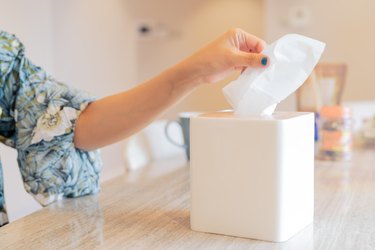
Like morning breath, eye crud is one of those common unpleasantries you often encounter in the a.m. upon waking. While a little eye gunk is totally normal, there are some circumstances — like a change in color, consistency or amount of eye discharge — that may signal something more serious.
Here, ophthalmologists help us decode the meaning of our eye boogers and explain when it's time to get your eye goop checked out by a professional.
Video of the Day
Video of the Day
1. Clear Eye Discharge
Eye boogers that are clearer in color can be a normal response to a minor irritation from the environment, Usiwoma Abugo, MD, spokesperson for the American Academy of Ophthalmology and assistant professor of ophthalmology at Eastern Virginia Medical School, tells LIVESTRONG.com.
"The eye increases tear production and mucin production as a mechanism to trap the irritants and remove them from the ocular surface," she explains.
And it's nothing to worry about — this type of discharge should go away within 48 hours.
2. White Eye Discharge
Often, white eye discharge — commonly associated with itching, redness, swollen eyelids and a foreign body sensation (the feeling that there's something in your eye) — is a sign of allergies and your body's immune response to something that's typically harmless, Dr. Abugo says.
The best way to treat allergies is to remove or avoid the allergen (think: dust, dander, pollen), Dr. Abugo says. So, for example, to steer clear of pollen, drive with the windows closed and use air conditioning instead. And try not to rub your eyes, which can increase irritation. You can also use artificial tears and antihistamines or get allergy shots to help you manage allergies, she says.
In many cases, white eye discharge can also result from dry eyes, says Neha Shaik, MD, an ophthalmologist and assistant professor at Mount Sinai. Over-the-counter dry-eye therapy such as artificial tears, eye drops or a nighttime lubricant eye ointment can provide relief, but always consult with your eye doctor if symptoms worsen or progress, she says.
Still, in other cases, white eye discharge can indicate a condition called blepharitis, which is an inflammation along the eyelid, Dr. Abugo says.
"Blepharitis has various causes, ranging from meibomian gland dysfunction, staphylococcal infection or seborrheic inflammation, and can be associated with skin conditions like dandruff or rosacea," she says.
In addition to discharge, you may also note eyelid redness, burning, foamy tears, crusting, an occasional foreign body sensation and, in severe cases, eyelash misdirection, eyelash loss and blurred vision, Dr. Abugo says.
Usually, warm compresses and eyelid scrubs are sufficient to resolve this issue. The National Eye Institute recommends these steps for cleaning your eyelids when you have blepharitis:
- Wash your hands with soap and water.
- Mix warm water with a gentle cleanser, like baby shampoo.
- Dip a clean, soft cloth in the water-soap mixture and press it against your closed eye to loosen crusts.
- Gently rub the cloth on the area where your eyelashes meet your eyelids.
- Rinse your eye with clean water, then repeat these steps on your other eye using a new cloth.
"When your symptoms are severe, your eye doctor may prescribe drops, ointment and/or an oral antibiotic to aid in decreasing the inflammation in your eyelids," Dr. Abugo adds.
3. Yellow or Green Eye Discharge
If your eye is oozing yellow or green discharge, you likely have an infection.
"Yellow discharge can be seen with bacterial and viral infections, whereas green discharge is more typical of a bacterial infection," Dr. Abugo says.
"Viral infections can present with fever, upper respiratory tract infection, swollen preauricular lymph nodes [which sit just in front of the ears], eyelid skin lesions, a foreign body sensation, redness, light sensitivity, pain and decreased vision," Dr. Abugo says.
Also worth noting: A copious amount of clear discharge may indicate viral conjunctivitis, too.
Your physician may prescribe topical lubricating drops/ointment, cool compresses and, in some cases, an antiviral topical and/or oral medication.
Bacterial infections — most commonly caused by Staphylococcus, Streptococcus and Hemophilus influenzae — develop more rapidly, Dr. Abugo says. The source of the infection is often related to poor hand hygiene, contact lens overwear or contaminated cosmetics, but bacterial conjunctivitis can also be associated with ocular diseases like dry eye or blepharitis.
Treatment includes artificial tears, cool compresses, antibiotic drops and, in more severe cases, an oral medication.
4. Sticky Eye Discharge
While sticky eye discharge can be associated with a bacterial infection, it can also sometimes be related to eyelid malposition. For instance, some people experience laxity or looseness of the upper or lower eyelids, a condition called ectropion, which causes your eyelid to be in an abnormal position, leading to inflammation, irritation and mucus buildup, Dr. Abugo says.
Your doctor may start with a conservative treatment, such as lubricating drops and ointment, but, ultimately, an eye surgeon may need to perform a tightening procedure to permanently resolve this, Dr. Abugo says.
Floppy eyelid syndrome is another condition that, when severe, can also cause a sticky discharge. This is a disease of the elastin fibers in the eyelid that causes the eyelid to flop open when sleeping, which may result in irritation and an increase of discharge, Dr. Abugo says.
To treat floppy eyelid syndrome, your doctor may prescribe lubrication as well as taping down your eyelids and using protective eye shields to keep your eyes shut (and prevent flopping) during sleep.
What's more, this condition appears to be linked to sleep apnea, so your doctor may also recommend a sleep study as well, Dr. Abugo says.
5. Crusty Eyes
Wake up with crusty eyes? The culprit of your eye crust is most likely dryness, says Dr. Shaik, who recommends starting with OTC dry eye therapy such as artificial tears and nighttime gel.
Crusting of the eyes is also commonly associated with blepharitis.
"The inflammation along the eyelids causes a crust to develop at the base of your eyelashes along the eyelid," Dr. Abugo says.
Again, this issue can usually be resolved with warm compresses and eyelid scrubs.
6. No Eye Boogers at All
Not an eye booger in sight? "That's totally normal and healthy," Dr. Shaik says.
If you don't have eye gunk but you do experience other symptoms, such as itching, pain, decreased vision, redness and a foreign body sensation, make sure to discuss these changes with your eye physician, Dr. Abugo says.
Is this an emergency? If you are experiencing serious medical symptoms, please see the National Library of Medicine’s list of signs you need emergency medical attention or call 911.


